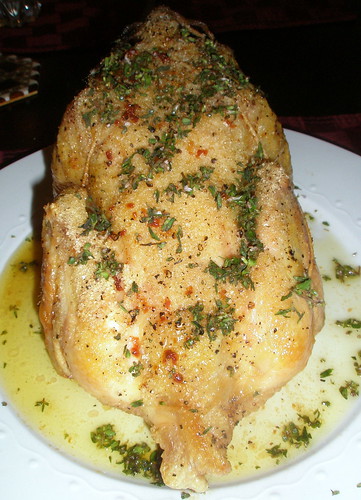A recent visit to Williamsburg, Brooklyn, brought me to The Meat Hook, one of two hipster-run butchers--the other being Marlow and Daughters--that has recently opened in the neighborhood. Although I lauded these new school butchers for their focus on selling locally-sourced meats and offering off-cuts that are difficult to find elsewhere, I remained skeptical of young, hip, personable butchers, and with nary a scar on their arms. Could the cool butcher's at The Meat Hook possibly be better than the gruff, old-school butchers from whom I am more accustomed to purchasing my meat? There was only one way to find out.
Staring at the wide array of sausages and cuts in the meat case, I had no idea what to purchase. Slightly intimidated by the butcher, who not only was better-looking than I, but could also break down a whole hog in the time it takes me to chop a bunch of parsley, I blurted out "I'll have what she's having," unsure of whether the lady in front of me was more excited by the butcher or the tenderloin from locally-bred pork that he was trimming for her. The kind butcher went to the meat locker, pulled out a tenderloin and began trimming it for me. Five minutes later, I was on my way back to Manhattan, pork tenderloin in hand.
Once home, I prepared the pork as simply as I could. I brined it using Thomas Keller's brine from Ad Hoc at Home
The verdict? While the brine no doubt helped make the pork exceptionally juicy and tender, I have to commend my butcher at the Meat Hook, who sold me an excellent piece of meat. Eddie - 0, Meat Hook Butcher - 1.
Brined Pork Tenderloin with Salsa Verde
Serves 6
For the Brine:
- 1/4 cup plus 2 tbsp honey
- 12 bay leaves
- 3 rosemary sprigs
- 1/2 bunch thyme
- 1/2 bunch parsley
- 1/2 cup garlic cloves, crushed
- 2 tbsp peppercorns
- 1 cup kosher salt
- 8 cups water
- 1 cup parsley leaves
- 1/2 tsp red pepper flakes
- 1/2 cup bread crumbs, toasted
- 1 clove garlic, peeled and crushed
- 1/2 cup olive oil
- 2 tbsp lemon juice
- salt, to taste
- 2 1 lb. pork tenderloins
- salt and pepper
- olive oil
- 2 tbsp butter
- 2 garlic cloves, crushed
- 6 thyme sprigs
- 2 rosemary sprigs
- Make the brine a day ahead of cooking the pork. Combine the honey, rosemary, thyme, parsley, garlic cloves, peppercorns, kosher salt, and water in a large pot and bring to a boil. Boil the brine for two minutes, stirring it well to dissolve the salt. Remove the pot from the heat and bring it to room temperature. Place the brine in the refrigerator and let it cool overnight.
- Place the pork tenderloins in the brine and refrigerate them for 4 hours.
- Meanwhile, prepare the salsa verde. Combine the parsley leaves, bread crumbs garlic, and pepper flakes in the bowl of a food processor. Pulse the mixture a few times until the ingredients are chopped and well-combined. Then, slowly pour in the olive oil while running the food processor. Blend until a smooth paste forms. Stir in the lemon juice and taste for salt. Set the salsa verde aside or refrigerate it for a later use.
- Preheat the oven to 350F.
- Remove the pork from the brine. Rinse it off and pat it dry with paper towels. Season the pork with salt and pepper.
- Heat the olive oil in a large skillet over medium-high heat. Add the pork and until it is well-browned on all sides, about 6 minutes.
- Add the butter, garlic, thyme, and rosemary to the pan and cook for another 2 minutes, turning the pork frequently and basting it with the butter.
- Transfer the pork to a roasting rack. Place it in the oven and cook until it is cooked through, about 20 minutes. Remove the pork to a plate and tent it with foil. Let the pork rest for 15 minutes.
- Slice the pork on the bias into 3/4-inch slices. Serve it with the salsa verde.















